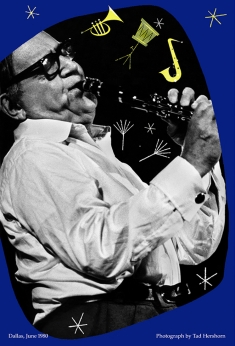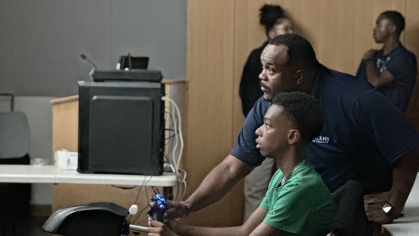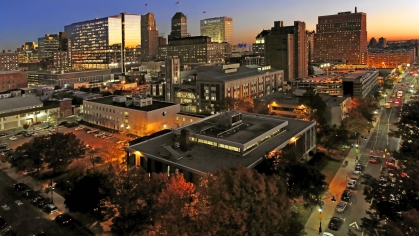Oct. 18 - Dec. 13 Exhibition in Newark Will Celebrate the Intersecting Roles of African Americans, Jews and Jazz
The Rutgers Institute of Jazz Studies and the John Cotton Dana Library of Rutgers University-Newark are collaborating with Newark cultural and community organizations to chronicle the interactions that occurred between Jews and African Americans throughout the history of jazz and continue today. Jews, African Americans and Jazz: Cultural Intersections in Newark and Beyond will also focus on prominent Newark institutions, musicians and others who have made their mark in the jazz world. It opens with a reception 1-5 p.m. on Sunday, Oct. 18 at the Jewish Museum of New Jersey, housed at Congregation Avahas Shalom, 145 Broadway, Newark, and concludes on Sunday, Dec. 13. The reception featuring jazz violinist Aaron Weinstein and his trio is free and open to the public.
Related events include:
- The Wells Fargo Jazz for Teens at the Clinton Memorial A.M.E. Zion Church, 151 Broadway, Newark, Nov. 15, 2 p.m., free;
- Newark artist and photographer Mansa K. Mussa, conducts a workshop, “How to Make a Romare Bearden-Inspired Collage,” at the Jewish Museum of New Jersey, 145 Broadway, Newark, Nov. 22, 2-5 p.m., no registration needed, free;
- Closing reception with pianist, composer and historian Ben Sidran at the Jewish Museum of New Jersey, 145 Broadway, Newark, Dec. 13, 2 p.m., free.
Producers of the 
Leading the effort on behalf of the Institute are archivist Tad Hershorn, who is curating and designing the exhibit; director of operations Vincent Pelote; and newly appointed executive director Wayne Winborne. “This has been a wonderful opportunity for the Institute of Jazz Studies to be a part of communities, which in many cases we have not been involved, and to hear different points of views on the topics,” said Hershorn. “It is through this exploration that I have been able to visually conceptualize the exhibit and accompanying text.”
The exhibit highlights the many roles that Jews have assumed in jazz: musicians; record company executives and producers; concert impresarios; managers; writers, critics and historians; photographers; composers and songwriters who helped build the Great American Song Book; and club owners, among others.
Newarkers to be profiled include:
- Wayne Shorter - saxophonist, composer and leader, whose 60-year career as a top jazz musician featured stints with Horace Silver, Miles Davis and Weather Report;
- Sarah Vaughan, one of jazz’s all-time iconic vocalists;
- Amiri Baraka, author, poet and firebrand cultural/political activist;
- Lorraine Gordon, whose first husband Alfred Lion founded Blue Note Records, followed by her second husband Max Gordon whom she succeeded as owner of the Village Vanguard;
- Rhoda Scott, organist who realized her greatest fame in Europe before returning to Newark several years ago;
- James Moody, alto saxophonist a longtime Newark resident and associate of trumpeter Dizzy Gillespie;
- Stride pianists James P. Johnson, Willie “The Lion” Smith, and Donald Lambert;
- Grachan Moncur III, free jazz trombonist and composer;
- Teddy Reig, record producer who worked for Newark’s own Savoy Records (where he recorded some of alto saxophonist Charlie Parker’s early classic records) and later Roulette Records;
- Paul Bacon, designer best known for his work on dust jackets for such books as Portnoy’s Complaint and Catch 22, but also for designing covers for over 200 albums for the Blue Note and Riverside labels;
- Barbara Kukla, a writer whose devotion to Newark jazz history has resulted in two books and;
- Dan Morgenstern and Ed Berger, former director and associate director, respectively, of the Institute of Jazz Studies, and director of operations Vincent Pelote, who worked together for 34 years;
The exhibit will also address longstanding and sensitive questions surrounding the contributions of non-African American groups -- including Jews -- making their mark in an African American art form. These issues take center stage with “blackface” traditions, in which white performers assumed a black identity to convey their music by obscuring their identities under a layer of burnt cork, most popularly recalled by Al Jolson’s performance in the 1927 film The Jazz Singer (which in reality had nothing to do with jazz). Equally controversial is the question of whether those non-African Americans were guilty of appropriating jazz to succeed in the entertainment business, leading African Americans to feel frustrated and resentful as others capitalized on their treasured musical legacy.
Also examined will be the vile degradation of Jews, African Americans and jazz through Nazi propaganda, which disparaged jazz as “degenerate art,” and the toxic anti-Semitic writings of automobile magnate Henry Ford.
Finally, another aspect of the Newark story will illuminate the state of jazz in the city today.
For further information, please contact Max Herman, president of the Jewish Museum of New Jersey at mherman2@njcu.edu, or Tad Hershorn at the Institute of Jazz Studies at hershorn@rulmail.rutgers.edu.

